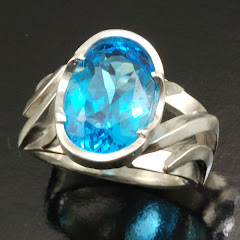 |
| Kiss Pendant |
1. Click together two pieces of Bakelite. Real Bakelite will produce a distinct clicking sound.
2. Put the piece in hot water, rub with your finger, and sniff. True Bakelite will smell like camphor.
3. The 409 test. You will want to do this in an inconspicuous place on the jewelry just to be safe. Dab a little 409 on a Q-tip and rub it in the Bakelite. If its true Bakelite the cotton will take on a yellow patina. Rinse the piece of jewelry after you apply. Alternately you could apply simichrome, a metal polish.
4. Heat up a small pin with a match and try to poke into the piece. True Bakelite is very heat resistant so the pin won't go through. This could damage the piece if its another material, so this test should be saved as a last option.
You will want to use the less invasive options first, leaving options three and four if there is still any doubt. As you become more familiar with the features of vintage carved Bakelite you'll be able to get a good idea of its properties on sight. Unless you trust the source online its best to see the piece before you buy, and perform a couple of these simple tests to be sure.






No comments:
Post a Comment